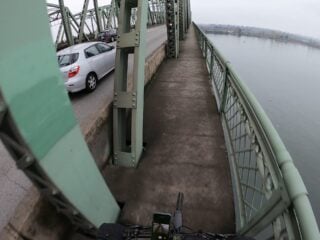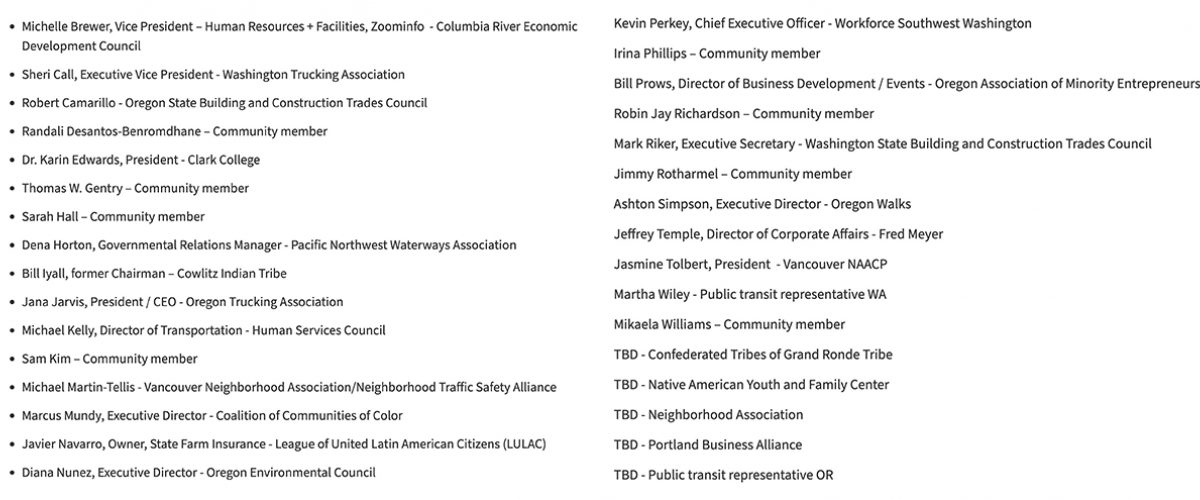
(Photo: Jonathan Maus/BikePortland)
Wednesday evening is the first meeting of the community advisory group (CAG) for the I-5 Bridge Replacement program — the new effort from Washington and Oregon departments of transportation to improve the crossing of the Columbia River between Portland and Vancouver. It’s one of three advisory groups that will help the DOTs avoid the fate of the failed Columbia River Crossing project.
Getting to the bridge and crossing the river is currently terrible for bicycle users and this project could attract billions of federal dollars to make it better. It’s a once-in-a-lifetime opportunity to make it easy to bike between these two growing cities — both on the bridge itself and on street connections on both ends.
However, despite the importance of bicycling in this project and the project’s own contention that the CAG will, “develop recommendations to help ensure the program outcomes reflect community needs, issues and concerns,” the 32-member body does not include anyone who represents a cycling advocacy group.
Advertisement

The CAG includes members who represent a myriad of interests including: Washington Trucking Association, Clark College, Oregon Walks, Portland Business Alliance, Cowlitz Indian Tribe, Oregon Trucking Association, Oregon Environmental Council, Fred Meyer, Columbia River Economic Development Council, Pacific Northwest Waterways Association, Oregon State Building and Construction Trades Council, two public transit representatives that are yet to be named, and several others.
Not one name on the list is from a bicycling organization from either side of the river.
Asked about this oversight, IBR Program Administrator Greg Johnson told BikePortland via email:
“As part of the process to identify members, the selection committee carefully considered the overall makeup of the group to ensure a diverse range of stakeholder interests and backgrounds are represented on the group. Active transportation interests were certainly part of this consideration and several of the at-large members of the Community Advisory Group identified themselves as avid cyclists. In particular, one of those members indicated that they commute across the bridge by bike each weekday for work.
In addition to making sure that the cyclist perspective is represented on the Community Advisory Group, we are planning many different ways for community members to provide input on the program. We anticipate specific opportunities to ensure the cyclist and pedestrian perspectives are engaged in a meaningful way, such as a potential working group to inform specific conversations around bike and pedestrian facilities when we begin to discuss the potential design details of possible alternatives.”
Advertisement
This is very unfortunate (yet part of a familiar pattern at ODOT).
There’s a vast difference between self-described “avid cyclists” on a committee representing themselves, versus a professional advocate who’s there to speak up for bicycling in general (and who carries the weight of an organization behind them). And having “bike and pedestrian facilities” discussed as a “potential design” and “possible alternatives” comes nowhere close to cutting it.
There are several nonprofits in the Portland and Vancouver areas who would have been important additions to this process: WashCo Bikes, The Street Trust, Bike Loud PDX, Bike Clark County, Cascade Bicycle Club, Washington Bikes, and Vancouver Bicycle Club just to name a few. And this list doesn’t include micro-mobility companies like Lyft and Spin whose customers are likely to be major users of a new bridge and other infrastructure.
It’s almost as if the DOTs don’t think bicycling and micromobility use are important enough to merit representation.
Keep in mind, ODOT is already in the hot seat for doing a bad job getting feedback from bicycle users. Back in September, The Oregonian reported on a state audit that pointed out how ODOT, “doesn’t do enough to reach out to bike and pedestrian advocacy groups about how they are affected by massive state transportation projects and those constituent groups are omitted from a powerful state committee that is dominated by freight interests.”
This is not a good start to a process that already faces deep skepticism from many corners. If the DOTs want this project to succeed, the process needs to be fair and accessible to everyone who will use the bridge.
Learn more about this project and get CAG meeting details here.
— Jonathan Maus: (503) 706-8804, @jonathan_maus on Twitter and jonathan@bikeportland.org
— Get our headlines delivered to your inbox.
— Support this independent community media outlet with a one-time contribution or monthly subscription.


